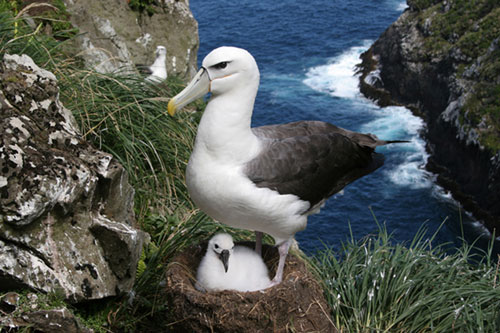Barry Baker, Katrina Jensz and Ross Cunningham (Latitude 42 Environmental Consultants) have produced a draft final report for the Conservation Services Programme of the New Zealand Department of Conservation detailing population trends in Near Threatened White-capped Albatrosses Thalassarche steadi breeding on New Zealand’s Auckland Island Group, including on Adams and Disappointment Islands.

A White-capped Albatross guards its chick, photograph by David Thompson
The report’s executive summary follows:
“White-capped albatrosses Thalassarche steadi are endemic to New Zealand, breeding on Disappointment Island, Adams Island and Auckland Island in the Auckland Island group, and Bollons Island (50-100 pairs) in the Antipodes Island Group. Population estimates suggest most (95%) of the global population breeds on Disappointment Island, an area where access is restricted to maintain environmental values at the site. Virtually all aspects of the biology and ecology of white-capped albatrosses are poorly known and although approximate population sizes have developed there have been no well-documented population estimates for any of the colonies until this study.
Between 2006/07 and 2013/14 (hereinafter 2006 and 2013, respectively) we undertook repeated population censuses of the white-capped albatrosses breeding in the Auckland Islands using aerial photography. These population censuses were carried out in either December or January each year to estimate population size and track population trends.
In 2013 we estimated that there were 89,552 (95%CI 88,953 — 90,151), 5,542 (5,393 — 5,691) and 184 (157— 211) annual breeding pairs at Disappointment Island, South West Cape and Adams Island, respectively, based on the raw counts, giving a total for these sites of 95,278 (94,661 — 95,895) breeding pairs.
To assess population trend in total counts we used an appropriate Generalised Linear Model where the response was specified as an over dispersed Poisson distribution and the link was logarithmic. To allow for possible non-linear trend effects we used regression splines with a single knot at 2010. We also assessed trend using software program TRIM (TRends and Indices for Monitoring Data), the standard tool used by the Agreement for the Conservation of Albatrosses and Petrels (ACAP).
Evidence from a series of ‘close-up’ photographs taken each year (2007-2013) indicates that the number of non-breeding birds present in the colonies differed somewhat between December and January. The proportion was very low in December counts (1-2% of birds present), but higher in the January counts (14% of birds present). Estimated annual counts for all three breeding sites in the Auckland Islands were adjusted to account for the presence of non-breeding birds, giving adjusted estimates of annual breeding pairs of 116 025, 90 036, 96 118, 73 838, 76 119, 92 692, 102 273 and 74 031 for each year from 2006 to 2013 inclusive. These adjusted figures were used as inputs into models used for assessment of population trend.
Trend analysis for all sites combined using regression splines showed no clear evidence for systematic monotonic decline over the 8 years of the study. This is particularly so if the count for 2006 is excluded. Given this we do not have sufficient evidence to reject the null hypothesis of no systematic trend in the total population. The population size estimates computed from the TRIM model indicate an average growth rate of -3.16% per year (λ = 0.9684 ± 0.001; assessed by TRIM as moderate decline. We note, however, that a simple linear trend analysis, as performed by TRIM is not well suited to a data set with high inter-annual variability. Trend analysis using regression splines is more appropriate to such data sets, and the TRIM analysis is only presented because it is currently used by ACAP to assess population trends in albatross populations.
In a global review of fisheries-related mortality of shy and white-capped albatrosses it was estimated that 8,000 white-capped albatrosses were killed each year as a result of interactions with trawl and longline fisheries in the Southern Ocean. This level of mortality highlights the need to continue to acquire accurate population estimates and trends for white-capped albatross populations to assess the impact of fisheries operations on this species. Although annual counts over the last eight years indicate the population is stable, ongoing population monitoring is recommended to clarify if current levels of fishing mortality remain sustainable.”
Reference:
Baker, G.B., Jensz, K. & Cunningham, R. 2014. White-capped Albatross Aerial Survey 2014 Draft Final Report. Report prepared for Department of Conservation Contract 4523/4524. [Kettering]: Latitude 42 Environmental Consultants Pty Ltd. 19 pp.
John Cooper, ACAP Information Officer, 25 November 2014

 English
English  Français
Français  Español
Español